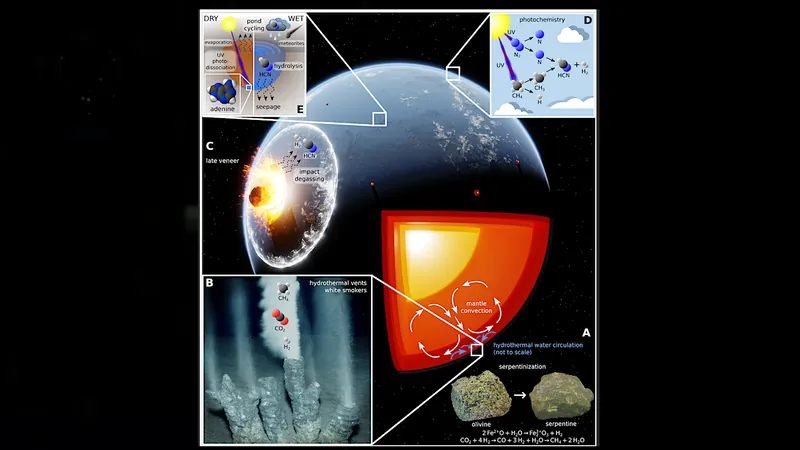
Unraveling the Origins of Life: How Early Earth Conditions Fostered Biomolecule Formation
2025-03-21
Author: Rajesh
Introduction
The quest to understand the environmental conditions on early Earth during the Hadean eon, and the implications for the origins of life, continues to be a complex and enthralling challenge for scientists. Recent studies suggest that geological processes and external bombardments played critical roles in shaping the atmosphere conducive to life’s building blocks.
Serpentinization and Atmospheric Conditions
One notable process is serpentinization, a chemical reaction between water and certain minerals in the Earth’s mantle that generates hydrogen gas. This phenomenon, combined with the impact of chondritic material—primarily composed of carbon-rich meteorites—during Earth’s late veneer, may have created a reducing atmospheric environment. Such conditions would enable the photochemical synthesis of hydrogen cyanide (HCN), an essential precursor to prebiotic molecules.
Formation of Biomolecules in Warm Little Ponds
HCN can precipitate and accumulate in warm little ponds (WLPs), which could serve as laboratories for the formation of vital biomolecules such as nucleobases and ribose, a sugar fundamental to RNA. These compounds are crucial for the creation of nucleotides, the building blocks of RNA itself, which is believed to hold the keys to life as we know it.
Research Findings on Prebiotic Molecule Concentrations
Through a meticulous investigation, researchers evaluated various sources of reducing gases during the Hadean epoch and calculated the potential concentrations of prebiotic molecules in WLPs using a detailed geophysical and atmospheric model. Their findings indicate that in a hydrogen-rich atmosphere, carbonaceous bombardment could yield HCN concentrations sufficient to reach approximately 1-10 mM for nucleobases and up to 10-100 µM for ribose, given minimal leakage from these ponds.
Comparative Analysis of Atmospheric Scenarios
Conversely, if the Hadean atmosphere were initially oxidized and rich in carbon dioxide, serpentinization would still create reducing conditions but at significantly lower concentrations than those produced by carbonaceous bombardment. Despite this, the amounts generated in both scenarios appear to be adequate for nucleotide synthesis, as corroborated by experimental studies.
The Emergence of RNA
Remarkably, RNA could have emerged on Earth soon after it became capable of supporting life—which was roughly 100 million years following the colossal Moon-forming impact—or possibly appeared later, continuing its journey through the early Archean eon.
Conclusion
The intricate processes involved in generating life's building blocks during the Hadean period are artistically illustrated by an imagined 'HCN machine.' This complex assembly encompasses geological reactions, atmospheric chemistry, and the influence of meteorite impacts that collectively create a nourishing environment for the emergence of life.
As research continues to illuminate the enigmatic conditions of our planet's formative years, the narrative of life’s origins becomes increasingly compelling. The interplay of geological and atmospheric processes unveils a dynamic battlefield where the very essence of life was forged from the depths of chemical chaos—an exploration that continues to intrigue both scientists and curious minds alike.

 Brasil (PT)
Brasil (PT)
 Canada (EN)
Canada (EN)
 Chile (ES)
Chile (ES)
 Česko (CS)
Česko (CS)
 대한민국 (KO)
대한민국 (KO)
 España (ES)
España (ES)
 France (FR)
France (FR)
 Hong Kong (EN)
Hong Kong (EN)
 Italia (IT)
Italia (IT)
 日本 (JA)
日本 (JA)
 Magyarország (HU)
Magyarország (HU)
 Norge (NO)
Norge (NO)
 Polska (PL)
Polska (PL)
 Schweiz (DE)
Schweiz (DE)
 Singapore (EN)
Singapore (EN)
 Sverige (SV)
Sverige (SV)
 Suomi (FI)
Suomi (FI)
 Türkiye (TR)
Türkiye (TR)
 الإمارات العربية المتحدة (AR)
الإمارات العربية المتحدة (AR)